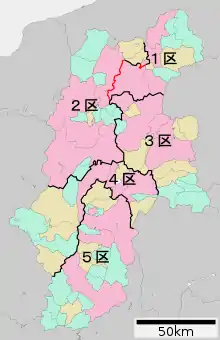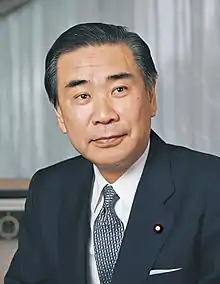Nagano 3rd district
Nagano 3rd district (長野県第3区, Nagano-ken dai-sanku or 長野3区, Nagano sanku) is a single-member constituency of the House of Representatives, the lower house of the national Diet of Japan. It is located in central and eastern part of Nagano Prefecture and consists of Ueda City, Komoro City, Chikuma City, Saku City, Tōmi City, Minamisaku District, Kitasaku District, Chiisagata District and Hanishina District. As of December 2020, 400,529 eligible voters were registered in the district.[1]
| Nagano 3rd district | |
|---|---|
| Parliamentary constituency for the Japanese House of Representatives | |
 Numbered map of inner Nagano single-member districts | |
| Prefecture | Nagano |
| Proportional District | Hokurikushin'etsu |
| Electorate | 400,529 (2020)[1] |
| Current constituency | |
| Created | 1994 |
| Seats | One |
| Party | Liberal Democratic |
| Representative | Yousei Ide |
| Created from | Nagano 2nd district (1947–1993) |
| Municipalities | Ueda, Komoro, Chikuma, Saku, Tōmi, Minamisaku, Kitasaku, Chiisagata and Hanishina |
Yousei Ide, a Liberal Democrat, has represented this district since December 2014.
List of members representing the district
| Member | Party | Dates | Electoral history | Notes |
|---|---|---|---|---|
 Tsutomu Hata |
New Frontier | October 21, 1996 – December 26, 1996 |
Redistricted from the former 2nd district and Re-elected in 1996. Re-elected in 2000. Re-elected in 2003. Re-elected in 2005. Re-elected in 2009. Retired. |
Prime Minister of Japan (1994) |
| Sun | December 26, 1996 – January 23, 1998 | |||
| Good Governance | January 23, 1998 – April 27, 1998 | |||
| Democratic | April 27, 1998 – November 16, 2012 | |||
| Yoshiyuki Terashima | Democratic | December 17, 2012 – November 21, 2014 |
Elected in 2012. Lost re-election. |
Lost re-election in the Hokurikushin'etsu PR block. |
| Yousei Ide | Innovation | December 15, 2014 – March 27, 2016 |
Re-elected in 2014. Re-elected in 2017. |
Elected in 2012 by the Hokurikushin'etsu PR block. |
| Democratic | March 27, 2016 – October 3, 2017 | |||
| Kibō | October 3, 2017 – May 7, 2018 | |||
| Independent | May 7, 2018 – December 21, 2019 | |||
| Liberal Democratic | December 21, 2019 – present |
Election results
2017
| Party | Candidate | Votes | % | |
|---|---|---|---|---|
| Kibō | Yousei Ide | 127,542 | 53.1 | |
| Liberal Democratic | Hitoshi Kiuchi | 74,722 | 31.1 | |
| Communist | Yuka Koganezawa | 34,462 | 14.3 | |
| Happiness Realization | Yukihisa Oikawa | 3,687 | 1.5 | |
| Total votes | 240,413 | 100.0 | ||
| Kibō hold | ||||
2014
| Party | Candidate | Votes | % | |||
|---|---|---|---|---|---|---|
| Innovation | Yousei Ide | 77,289 | 34.4 | |||
| Democratic | Yoshiyuki Terashima | 63,397 | 28.2 | |||
| Liberal Democratic | Hitoshi Kiuchi (re-elected by PR) | 56,365 | 25.1 | |||
| Communist | Chiaki Karasawa | 27,947 | 12.4 | |||
| Total votes | 224,998 | 100.0 | ||||
| Innovation gain from Democratic | ||||||
2012
| Party | Candidate | Votes | % | |
|---|---|---|---|---|
| Democratic | Yoshiyuki Terashima | 69,843 | 27.7 | |
| Your | Yousei Ide (elected by PR) | 67,750 | 26.9 | |
| Liberal Democratic | Hitoshi Kiuchi (elected by PR) | 62,539 | 24.8 | |
| Restoration | Taisuke Ide | 29,905 | 11.8 | |
| Communist | Syōsuke Iwaya | 21,433 | 8.5 | |
| Total votes | 251,470 | 100.0 | ||
2009
| Party | Candidate | Votes | % | |
|---|---|---|---|---|
| Democratic | Tsutomu Hata | 138,614 | 47.5 | |
| Liberal Democratic | Tadao Iwasaki | 106,574 | 36.5 | |
| Communist | Syōsuke Iwaya | 40,948 | 14.0 | |
| Happiness Realization | Manabu Ebara | 5,576 | 1.9 | |
| Total votes | 291,712 | 100.0 | ||
2005
| Party | Candidate | Votes | % | |
|---|---|---|---|---|
| Democratic | Tsutomu Hata | 143,728 | 51.1 | |
| Liberal Democratic | Tadao Iwasaki | 102,889 | 36.6 | |
| Communist | Syōsuke Iwaya | 34,669 | 12.3 | |
| Total votes | 281,286 | 100.0 | ||
2003
| Party | Candidate | Votes | % | |
|---|---|---|---|---|
| Democratic | Tsutomu Hata | 150,203 | 58.5 | |
| Liberal Democratic | Tadao Iwasaki (re-elected by PR) | 78,364 | 30.5 | |
| Communist | Syōsuke Iwaya | 28,083 | 10.9 | |
| Total votes | 256,650 | 100.0 | ||
2000
| Party | Candidate | Votes | % | |
|---|---|---|---|---|
| Democratic | Tsutomu Hata | 163,382 | 61.2 | |
| Liberal Democratic | Tadao Iwasaki (elected by PR) | 67,002 | 25.1 | |
| Communist | Ken'ichi Nakazawa | 34,110 | 12.8 | |
| Independent | Tokio Hosoya | 2,276 | 0.9 | |
| Total votes | 266,770 | 100.0 | ||
1996
| Party | Candidate | Votes | % | |
|---|---|---|---|---|
| New Frontier | Tsutomu Hata | 161,670 | 62.6 | |
| New Party Sakigake | Syōichi Ide | 70,960 | 27.5 | |
| Communist | Mizue Matsuzawa | 25,600 | 9.9 | |
| Total votes | 258,230 | 100.0 | ||
| New Frontier win (new seat) | ||||
References
- "市町村別選挙人名簿登録者数(衆議院選挙区別)" [Number of registered voters] (PDF) (in Japanese). Nagano Prefecture Election Commission. 2020.
- "長野3区". NHK (in Japanese). Retrieved 2020-12-30.
- 長野3区. NHK (in Japanese). Retrieved 2020-12-30.
- 長野3区. The Asahi Shimbun (in Japanese). Retrieved 2020-12-30.
- 長野3区. The Asahi Shimbun (in Japanese). Retrieved 2020-12-30.
- 長野3区. The Asahi Shimbun (in Japanese). Retrieved 2020-12-30.
- 長野3区
- 長野3区 (in Japanese). 選挙ドットコム. Retrieved 2020-12-30.
- 長野3区 (in Japanese). 選挙ドットコム. Retrieved 2020-12-30.
This article is issued from Wikipedia. The text is licensed under Creative Commons - Attribution - Sharealike. Additional terms may apply for the media files.